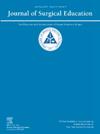外科医生工作量对术中沟通质量的影响:一项使用心脏手术期间生理评估工作量的观察性研究
IF 2.1
3区 医学
Q1 EDUCATION, SCIENTIFIC DISCIPLINES
引用次数: 0
摘要
目的探讨高负荷和低负荷期间术中沟通质量的差异,以确定手术培训中可能存在的差距。设计前瞻性观察性研究。记录了超过100小时的手术过程,并记录了外科医生、麻醉小组和灌注师之间的所有交流。通过测量外科医生的心率变异性来确定高负荷和低负荷的时间段。评估了各种工作负载条件下的通信质量标准,包括交换环路类型、实质性响应、定向交换和通信错误。背景:荷兰一所大学医学中心的心胸外科。参与者在选择性成人心脏直视手术中的24个手术室团队。结果与低工作量时期相比,外科医生开环反应(即无口头反应)的可能性显著降低(IRR = 0.75,95% CI: 0.63-0.88),而高工作量时期回叫反应的可能性显著增加(IRR = 1.14,95% CI: 1.01-1.29)。在高工作量期间,外科医生也不太可能给出实质性的回应(IRR = 1.23,95% CI: 1.04-1.46),也不太可能称呼他人的名字(IRR = 0.84,95% CI: 0.71-0.99)。当外科医生工作量大时,其他团队成员较少与外科医生交谈(IRR = 0.64,95% CI: 0.53-0.79)。他们也更有可能称呼外科医生的名字(IRR = 0.74,95% CI: 0.56-0.99),并在高工作量期间实质性地回复(IRR = 1.50,95% CI: 1.12-2.02)。结论术中沟通质量因工作量的不同而不同,在高工作量时,外科医生的指导性和实质性沟通较少。其他团队成员似乎相应地调整了他们的沟通行为,这有助于手术室团队在高压力情况下的弹性。这些结果突出了在线测量工作量对手术室中评估和培训非技术技能的重要性。本文章由计算机程序翻译,如有差异,请以英文原文为准。
The Effect of Surgeon Workload on Intraoperative Communication Qualities: An Observational Study Using Physiologically Assessed Workload During Cardiac Surgery
Objectives
To examine how intraoperative communication qualities differ during periods of high and low workload to identify possible gaps in surgical training.
Design
A prospective observational study. Over 100 hours of surgical procedures were recorded and all communication between the surgeon, anaesthesia team and perfusionist transcribed. Surgeons’ heart rate variability was measured to determine periods of high and low workload. Communication quality standards were assessed across workload conditions, including exchange loop-types, substantive responses, directed exchanges and communication errors.
Setting
A cardio-thoracic surgery department at a university medical centre in the Netherlands.
Participants
Twenty four operating room teams during elective adult open-heart cardiac surgeries.
Results
Compared to periods of low workload, surgeons were significantly less likely to respond in open loop (i.e. no verbal response) (IRR = 0.75, 95% CI: 0.63-0.88) and more likely to respond in call-back during periods of high workload (IRR = 1.14, 95% CI: 1.01-1.29). Surgeons were also less likely to give a substantive response during high workload (IRR = 1.23, 95% CI: 1.04-1.46) and less likely to address others by their name (IRR = 0.84, 95% CI: 0.71-0.99). Other team members addressed the surgeon less frequently when the surgeon was experiencing high workload (IRR = 0.64, 95% CI: 0.53-0.79). They were also more likely to address the surgeon by name (IRR = 0.74, 95% CI: 0.56-0.99) and reply substantively during high workload (IRR = 1.50, 95% CI: 1.12-2.02).
Conclusions
Intraoperative communication qualities varied across workload levels, with less directed and less substantive communication exchanges from the surgeon during high workload. Other team members appeared to adapt their communication behaviours accordingly, which contribute to the resilience in OR teams during high stress situations. These results highlight the importance of online measurements of workload for the assessment and training non-technical skills in the OR.
求助全文
通过发布文献求助,成功后即可免费获取论文全文。
去求助
来源期刊

Journal of Surgical Education
EDUCATION, SCIENTIFIC DISCIPLINES-SURGERY
CiteScore
5.60
自引率
10.30%
发文量
261
审稿时长
48 days
期刊介绍:
The Journal of Surgical Education (JSE) is dedicated to advancing the field of surgical education through original research. The journal publishes research articles in all surgical disciplines on topics relative to the education of surgical students, residents, and fellows, as well as practicing surgeons. Our readers look to JSE for timely, innovative research findings from the international surgical education community. As the official journal of the Association of Program Directors in Surgery (APDS), JSE publishes the proceedings of the annual APDS meeting held during Surgery Education Week.
 求助内容:
求助内容: 应助结果提醒方式:
应助结果提醒方式:


